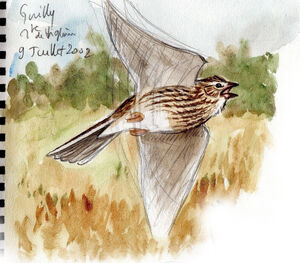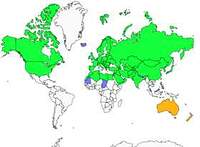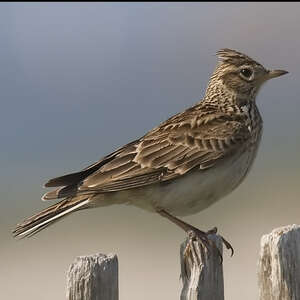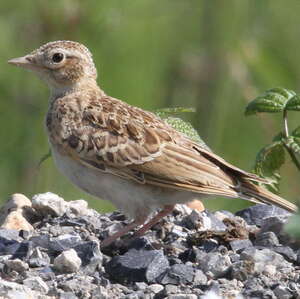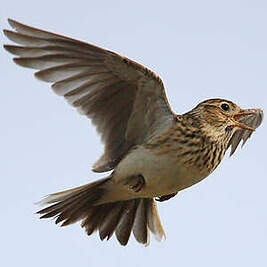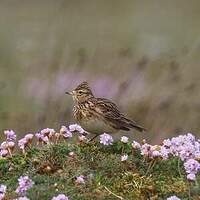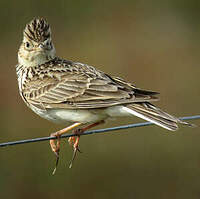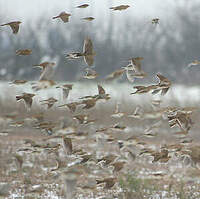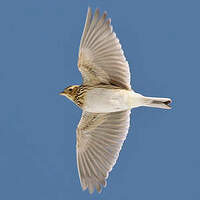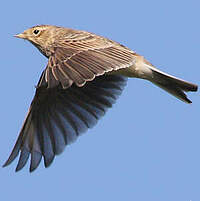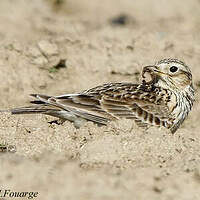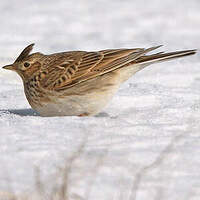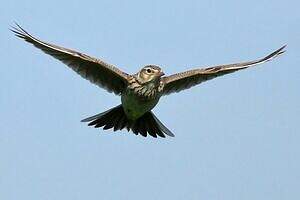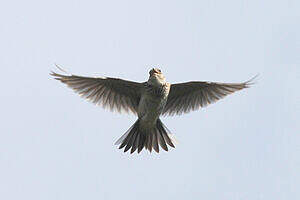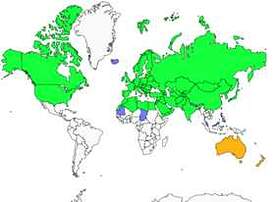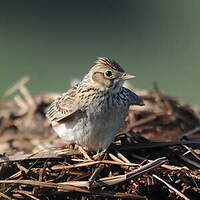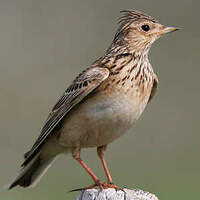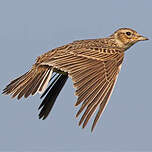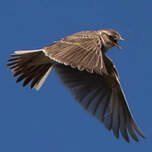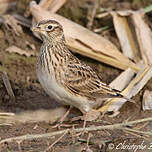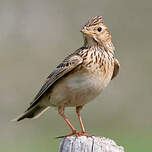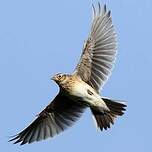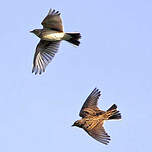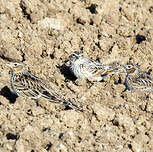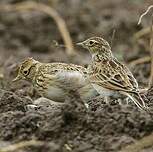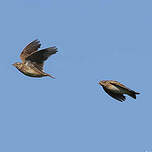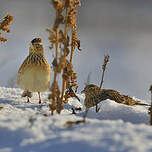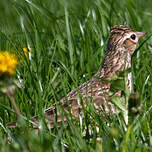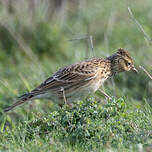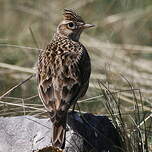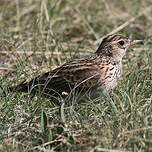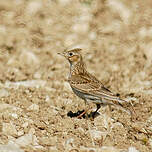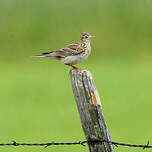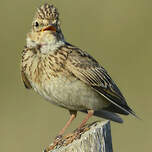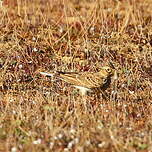Eurasian Skylark
Alauda arvensis - Alouette des champs
Identification
The Eurasian Skylark is a medium-sized bird (17.5 to 19 cm in length, with the male being the largest). It has a neutral plumage, without any outstanding features and often cryptic with the ground it moves on as it is a terrestrial bird. The upperparts are brown and the underside is notably paler. The mantle is chamois, streaked with dark brown. The coverts, remiges and central rectrices are brown and bordered with chamois. The wings are long with a long primary projection. The crown, neck and upper chest are light chamois and finely streaked with brown. The crown feathers are erect and can become a short crest when the bird is excited. The dark eye is surrounded by a white ring with brown edgings. This blends in with the whitish eyebrow, lores and white-cream sideburns or chamois. The earcoverts, bordered with chamois, often have a russet hue. The throat is white. A faint malar stripe in brown is noticeable. The bill is straight, quite long and straw-coloured or horn-coloured. The male's bill is more powerful than the female's, whose plumage is similar. The tail is tricoloured. The central rectrices are medium brown, the following pairs are some dark brown and the outermost one is distinctly white. This can be seen when the bird is flying and singing and when the male spreads the tail; it's also a good opportunity to see a light line formed by the white edging of the inner primaries and secondaries under the wings. The parts below the chest from the throat onwards are white. The upper flanks are reddish brown and lightly streaked with brown, as is the breast band. The legs are pink or rosé. The juvenile can be distinguished from the adult by its new scaly plumage. The feathers present a subterminal brown edging and a wide creamy chamois terminal edging.It is particularly evident in the wing covers and tertial remiges. The head seems to be speckled with white. 15 subspecies are described. They differ from each other only in details of plumage and measurements that are unnecessary to specify here.
Subspecific information 11 subspecies
- Alauda arvensis arvensis (n, w and c Europe)
- Alauda arvensis sierrae (Portugal, c and s Spain)
- Alauda arvensis harterti (nw Africa)
- Alauda arvensis cantarella (s Europe from ne Spain to Turkey and the Caucasus)
- Alauda arvensis armenica (se Turkey to Iran)
- Alauda arvensis dulcivox (se European Russia and w Siberia to nw China and sw Mongolia)
- Alauda arvensis kiborti (s Siberia, n and e Mongolia and ne China)
- Alauda arvensis intermedia (nc Siberia to ne China and Korea)
- Alauda arvensis pekinensis (ne Siberia, Kamchatka Pen. and Kuril Is.)
- Alauda arvensis lonnbergi (n Sakhalin I.)
- Alauda arvensis japonica (s Sakhalin I., s Kuril Is., Japan and Ryukyu Is.)
Foreign names
- Alouette des champs,
- Alondra común,
- laverca-comum,
- Feldlerche,
- mezei pacsirta,
- Veldleeuwerik,
- Allodola,
- sånglärka,
- Sanglerke,
- škovránok poľný,
- skřivan polní,
- Sanglærke,
- kiuru,
- alosa comuna,
- Sönglævirki,
- skowronek (zwyczajny),
- lauku cīrulis,
- poljski škrjanec,
- Полевой жаворонок,
- ヒバリ,
- 云雀,
- sånglärka,
- 歐亞雲雀,
Voice song and call
The song of the Eurasian Skylark is the dominant element of the soundscape of agricultural areas and other open grassland habitats. Males typically sing while in territorial flight, and occasionally while perched on a bush. The song is long and complex, very varied and melodic, and easily noticeable, particularly when several males start to sing together. Typically the song continues for some minutes without interruption and it is fairly easy to spot in the sky the singing bird, which moves slowly and vibrantly, wings spread, in circles above its territory, watched by the female. The songs performed during flight are more complex than songs performed on the ground, they can even include imitations of other species. The most frequent call is a rolling tchiirrp or tchiirrip, strongly uttered in migration as a contact call. The repertoire can seem rich, but for simplicity here we just describe the essential.
Habitat
The Eurasian Skylark is a bird of very open grassland habitats. Originally, it inhabited various types of natural meadows, including mountain meadow, heaths, steppes, and marsh edges.
Behaviour character trait
For all time, the Eurasian Skylark has had to attract the attention of Man with its sound presence in the countryside during the beautiful season.
The singing as well as the territorial flight, described above, cannot go unnoticed. They accompanied the work in the fields and were sure to join the evening's conversations around the fire. The song inspired many artists, fascinated by its wonderful variations. Everyone knows the popular song Alouette, gentille alouette..., or At the lark's song, I go and I sleep... Caesar created a legion Legio Quinta Alaudae, or the fifth legion of the Skylark, likely composed of Gauls who had skylark wings decorating their helmets. As a major characteristic of the species, one can note its gregariousness. Outside of the breeding season, skylarks willingly congregate into small flocks which can become important on the wintering grounds. It is in groups that they make their diurnal migration.Flight
The Eurasian Skylark has a direct and slightly undulating cruise flight. Its size, silhouette and especially its specific call help with identification, for example when tracking migration.
The male's territorial flight, during reproduction period, is very different. It is accompanied by singing from start to finish. This flight starts with a quick rise to a variable high altitude. From here, the male initiates slow orbits over its territory with very particular wing beats. Due to the slow flight, the beats are extremely fast while the tail is spread out to the maximum, which must favour flight balance and lift. And this can last what seems like an eternity. The male does not seem to tire. He performs some rapid pursuit against its potential competitors, then returns to its vibrating flight. He can modify the heights of the altitudes along the way. Of course there comes a moment where he has to come down. The descent is spectacular. From a last altitude, the male falls like a stone, with closed wings, and performs a sudden braking on arrival near the ground.Dietfeeding habits
The Eurasian Skylark looks for its food on the ground by walking calmly with small steps and a hunched back; it does not hop.
During the breeding season, it feeds alone or in pairs, but in the inter-season, the gregarious temperament takes over and hundreds of skylarks can feed in the same parcel of land, their cryptic plumage making them undetectable. It is mainly a granivore. It consumes all sorts of wild and cultivated seeds all year round. The spectrum of consumed seeds is very wide and concerns all herbaceous families. Cereal grains in the Poaceae family are a little added bonus. It can peck its way through the plant litter to find them, or even under a thin layer of snow in the winter and early spring. During the breeding season, invertebrates are also included in its diet as young ones need animal proteins for growth. Here too, the spectrum is wide.Reproduction nesting
The Eurasian Skylark is monogamous. The breeding season begins early in March and continues until summer.
It is evidenced by the territorial flights of the singing male. Nesting is terrestrial. Habitats where the soil is never wet and where the herbaceous layer is loose and not too high are preferred. The choice of the nest site falls to the female. Assisted by the male, she digs a small excavation sheltered by a tuft. Then she alone builds the nest with dry grass. The inner cup is lined with fine materials such as vegetable fibers, hairs or wool, for example from sheep. The female lays 3 to 5 gray-white eggs heavily spotted with brown-olive which she incubates alone for 11 to 12 days while the male continues his territorial displays. The chicks are fed by both parents and grow quickly. They leave the nest at around 9 to 10 days old and stay in the surrounding vegetation. They fly at the age of three weeks. Secondary clutches are systematic. The literature reports that the number of annual clutches per female can reach 4 in optimal habitat and climate conditions.Geographic range
The Eurasian Skylark has a wide distribution throughout the Eurasian continent, from the Atlantic coast to the extreme east of Russia and Japan in temperate latitudes. To the west, it is present from northern Scandinavia to the Maghreb and Turkey. 15 subspecies share this vast space. The birds in Eastern Europe and Asia are migratory and leave their breeding grounds to spend the winter in the Mediterranean Basin, around the Persian Gulf, between the Black Sea and the Caspian Sea, in southern Central Asia and in southeastern China.
Threats - protection
IUCN conservation status
concern
in the Wild
threatened
evaluated
The Eurasian Skylark is a widespread and generally common species, not endangered. However, recent population tracking reveals a distinct decrease in both breeding and migrating individuals. It is easy to imagine the reasons for this. Modern agriculture is often very intensive. The land is worked more frequently. Marginal uncultivated spaces are reduced to practically nothing. Finally, modern practices include the use of inputs, fertilizers, and various pesticides, which have a strong impact on vegetal diversity and the richness of the entomofauna.
Sources of information
- IOC World Bird List (v15.1), Gill, F and D Donsker (Eds). 2025-12-07.
- Les passereaux d'Europe, tome 1, P. Géroudet, M. Cuisin
- Birds of the World, The Cornell Lab of Ornithology
- xeno-canto, Sharing bird sounds from around the world,
Other sources of interest
 Specification sheet created on
12/07/2023 by Jean François
Specification sheet created on
12/07/2023 by Jean FrançoisTranslation by AI Oiseaux.net
© 1996-2026 Oiseaux.net
- Accipitriformes
- Aegotheliformes
- Anseriformes
- Apodiformes
- Apterygiformes
- Bucerotiformes
- Caprimulgiformes
- Cariamiformes
- Casuariiformes
- Charadriiformes
- Ciconiiformes
- Coliiformes
- Columbiformes
- Coraciiformes
- Cuculiformes
- Eurypygiformes
- Falconiformes
- Galliformes
- Gaviiformes
- Gruiformes
- Leptosomiformes
- Mesitornithiformes
- Musophagiformes
- Nyctibiiformes
- Opisthocomiformes
- Otidiformes
- Passeriformes
- Pelecaniformes
- Phaethontiformes
- Phoenicopteriformes
- Piciformes
- Podargiformes
- Podicipediformes
- Procellariiformes
- Psittaciformes
- Pterocliformes
- Rheiformes
- Sphenisciformes
- Steatornithiformes
- Strigiformes
- Struthioniformes
- Suliformes
- Tinamiformes
- Trogoniformes

